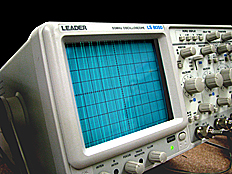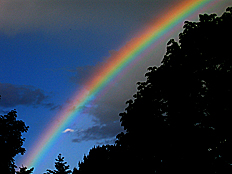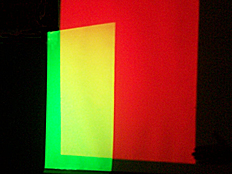 |
|
|
 |
|
|
 |
|
|
|
|
|
|
Light, Color, and Sound
Asa Packer Elementary
School, Spring 2010
Grade 4 |
|
|
|
|
|
|
 In this program, we learned about sound and light. We already knew that sound is a wave, and some of us even knew that light is a wave. Dr. DeLeo described a wave as a disturbance that moves from one place to another. The disturbance moves, but the stuff carrying the disturbance, like water or a long rubber hose, doesn’t go anywhere. Dr. DeLeo began the program with sound. Sounds can be loud and soft, and they can also be high pitch and low pitch. Dr. DeLeo had a machine that could make all sorts of sounds, and he connected this to an oscilloscope, like you see in hospital movies. Sound waves are disturbances of the air, where the air is squeezed together and stretched out and squeezed together and stretched out…. The green line on the oscilloscope went up and down like a water wave. But Dr. DeLeo explained that the green line was a graph, since sound waves don’t actually go up and down. The high points of the green line represent where the air is squeezed together, and the low points where it is stretched out. In this program, we learned about sound and light. We already knew that sound is a wave, and some of us even knew that light is a wave. Dr. DeLeo described a wave as a disturbance that moves from one place to another. The disturbance moves, but the stuff carrying the disturbance, like water or a long rubber hose, doesn’t go anywhere. Dr. DeLeo began the program with sound. Sounds can be loud and soft, and they can also be high pitch and low pitch. Dr. DeLeo had a machine that could make all sorts of sounds, and he connected this to an oscilloscope, like you see in hospital movies. Sound waves are disturbances of the air, where the air is squeezed together and stretched out and squeezed together and stretched out…. The green line on the oscilloscope went up and down like a water wave. But Dr. DeLeo explained that the green line was a graph, since sound waves don’t actually go up and down. The high points of the green line represent where the air is squeezed together, and the low points where it is stretched out.
|
|
|
|
| |
| We learned that soft sounds are waves that are small, like ripples in a pond. For a soft sound, the line on the oscilloscope looked like the picture just to the right. Loud sounds make big waves on the oscilloscope, like ocean tidal waves. For a loud sound, the line on the oscilloscope looked like the picture on the far right. |
|
|
|
|
|
|
|
|
We even guessed how the waves would change when we used high pitch and low pitch sounds. Can you guess? We did! High pitched sounds are scrunched together waves and low pitched sounds are stretched out waves! |
|
|
|
| |
|
|
|
|
| Dr. DeLeo took us out into the hallway in groups so we could make waves using a long rubber hose. We learned that no piece of the hose goes anywhere, but the disturbance still delivers energy. Click the play button on the picture on the left to see a video showing how the energy makes our heads bob! |
|
|
|
| |
| We all got to talk, or scream, or make other sounds into a microphone, which was connected to the oscilloscope. We could see what our voice sound waves looked like. |
|
|
|
|
|
|
|
| |
|
Click the play button on the picture on the right to see a video showing us making sounds and watching them appear on the oscilloscope. Those nice waves on the oscilloscope that look like water waves are called "sine waves."
|
|
|
|
|
|
| |
|
|
|
Dr. DeLeo made a make-believe movie he called “Beauty and the Beast.” He was the beast, and one of the girls in the class, one who could scream real loud, was the beauty. Dr. DeLeo acted like the monster in an old-fashioned horror movie. When the girl turned around and saw him, she screamed into the microphone. Then we could see what a loud scream looked like on the oscilloscope.
|
|
|
|
|
|
Dr. DeLeo had the machine make a pitch so high that we couldn’t hear it. He told us that bats communicate with each other at very high pitches, and he had a “bat detector” with him. It detects the high pitches that human ears can’t hear. Dr. DeLeo showed us how it picked up the high pitch sound from the speaker that we couldn’t hear. It made a chattering sound when it picked up high pitches. That is the noise it would make if there were a bat in the room. Dr. DeLeo checked the room for real bats, like in our sweatshirt hoods and in our hair. He even checked the teacher’s hair since he said that bats are often found around teachers. But, there were no bats in the classroom.
Dr. DeLeo told us that bats can find things even in complete darkness, and many of us knew that this was called echo-location. We are really smart!! He showed us how a Radio Shack “electronic tape measure” uses sound waves to measure distances. |
|
|
|
| |
|
|
|
Dr. DeLeo reminded us that light is a wave, and he told us that it is a wave of electricity and magnetism. It is like a water wave, only no material is necessary to support it. Light can travel through space even though there is nothing there. A bright light is a tall wave, just like a loud sound is a “tall” sound wave (at least the way it looks on an oscilloscope). For blue light, the waves are scrunched together (“short wavelength”). For red light, the waves are all stretched out (“long wavelength”). In fact, red light is like low pitch sound, and blue light is like high pitch sound.
|
|
|
|
|
|
  Although our ears can distinguish a mixture of different pitches, our eyes cannot distinguish a mixture of colors (we simply perceive another color!). Light that looks white to our eyes is actually a mixture of all colors. These colors can be separated by using a prism or a diffraction grating to create a spectrum. A rainbow is an example of a spectrum. Dr. DeLeo showed us how red and green lights mixed to produce yellow. He also showed us how white light is actually a mixture of all the colors in the rainbow. Ultraviolet and infrared light are parts of the spectrum that human eye can’t see, like sound pitches that are too high or too low for the human ear to perceive. Although our ears can distinguish a mixture of different pitches, our eyes cannot distinguish a mixture of colors (we simply perceive another color!). Light that looks white to our eyes is actually a mixture of all colors. These colors can be separated by using a prism or a diffraction grating to create a spectrum. A rainbow is an example of a spectrum. Dr. DeLeo showed us how red and green lights mixed to produce yellow. He also showed us how white light is actually a mixture of all the colors in the rainbow. Ultraviolet and infrared light are parts of the spectrum that human eye can’t see, like sound pitches that are too high or too low for the human ear to perceive. |
|
|
|
| |
| Dr. DeLeo showed us how the blue sky and red sunset were related. Sunlight contains a mix (a rainbow) of colors, and particles in the air scatter the blue part most of all. This is why the sky is blue. When the blue part is taken out of the beam, it leaves the red side of the rainbow as the colors that get through. Hence, a red (or orange) sunset. He demonstated this with a flashlight as the sun, and dry milk in water as the air. |
|
|
|
|
|
|
|
|
Dr. DeLeo showed us an infrared thermometer. If you aim it at something, it tells you its temperature by measuring the infrared energy it gives off. He bought it at Radio Shack, and it's really cool! The temperature of part of the slide projector that was just turned on was over 100 degrees. |
|
|
|
| |
|
|
| Dr. DeLeo was having trouble getting the teachers to open their mouths so he could take their temperatures. He warned us that if the temperature wasn't right, they could be aliens from outer space. When they finally opened their mouths, he measured 95 degrees, just about right. We were glad to find out that our teachers were human! |
|
|
|
|
|
| |
|
Dr. DeLeo told us how important it is to know that a beam of light could be bent – made to change direction – when it passes through clear materials such as glass or clear plastic shaped in certain ways. That’s how the lens in a camera or in a human eye makes a focused image. This is also how a magnifying glass or a pair of eye glasses work. We learned that when you put lenses together, you can make powerful instruments, like telescopes and microscopes. Dr. DeLeo gave us 30-power hand held microscopes to use to examine all sorts of things in the classroom. After the time was up, he could hardly get us to stop. Here are some photos of us looking at things in our classrooms.
|
|
|
|
|
|
|
|
|
|
|
|
Dr. DeLeo told us that light can be used to send messages. This is called optical communication. Your voice can be carried on a ray (beam) of light. This can be sent through the air, or through a thin glass wire called an optical fiber. A laser can be used to produce the light which carries your voice. Dr. DeLeo demonstrated this by sending the music from a little radio on a beam of light from a specially-wired flashlight to a speaker across the room. When he stood in front of the beam, the music went off!
|
|
|
|
| |
| Dr. DeLeo gave us a gift: An envelope containing three polarizing filters with instructions. A polarizer will only let light through when the electric force is in a certain direction. If a second polarizer is held in front of the first one, light will not pass through if it is turned the wrong way. The world is so interesting! |
|
|
|
|
|
|
|
|
|
|
I hope you have enjoyed this web presentation as much as we enjoyed sharing the actual learning experience with your son or daughter. Although we have endeavored to exclude photographs where permission has been denied, it is possible for errors to occur. If you would like us to remove a photograph of your son or daughter for any reason, please send me an e-mail message at lgd0@lehigh.edu or call me at 610-758-3413, and we will remove it promptly. Please note that we will never associate a child's full or last name with a photograph except in circumstances where special permission was explicitly provided. Thank you. Gary DeLeo. |
|
|
|
|
|
|
|
|